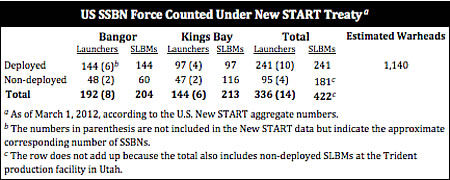
By Hans M. Kristensen
The U.S. State Department today released the full (unclassified) aggregate data for U.S. strategic nuclear forces as counted under the New START treaty. The data shows only very modest reductions of deployed strategic nuclear weapons over the past six months.
The full U.S. aggregate data follows the joint and much more limited overall U.S. and Russian aggregate numbers released in March 2012. Under the previous START treaty, the United States used to make Russian data available, but accepted Russia’s demand during the New START negotiations to no longer release their data.
The joint aggregate data and the full U.S. aggregate data are released at different times and not all information is made reality available on the Internet. Therefore, a full compilation of the data is made available here.
Overall U.S. Posture
The New START data attributes 1,737 warheads to 812 deployed ICBMs, SLBMs, and heavy bombers as of March 1, 2012. This is a reduction of 53 deployed warheads and 10 deployed delivery vehicles compared with the previous data set from September 2011.
A large number of non-deployed missiles and launchers that could be deployed are not attributed warheads.
The data shows that the United States will have to eliminate 289 launchers over the next six years to be in compliance with the treaty limit of 700 deployed and non-deployed launchers by 2018. Fifty-six of these will come from reducing the number of launch tubes per SSBN from 24 to 20, roughly 80 from stripping B-52Gs and nearly half of the B-52Hs of their nuclear capability, possibly retiring 50 ICBMs, and destroying about 100 old ICBM silos.

The released data does not contain a breakdown of how the 1,737 deployed warheads are distributed across the three legs of the Triad. But because the bomber number is now disclosed and each bomber counts as one warhead, and because between 450 and 500 warheads remain on the ICBMs, it appears that the deployed SLBMs carried 1,112 to 1,165 warheads, or about two-thirds of the total number of warheads counted by New START.
Just to remind readers: the New START numbers do not represent the total number of nuclear weapons in the U.S. arsenal – only about a third. The total military stockpile is just under 5,000 warheads, with several thousand additional retired (but still intact) warheads awaiting dismantlement. For an overview, see this article.
Ballistic Missile Submarines
The New START data shows that the United States as of March 1, 2012, had 241 Trident II SLBMs onboard its SSBN fleet. That is a reduction of eight SLBMs compared with the New START data from September 2011, but it doesn’t reflect an actual reduction in missiles on deployable submarines but a fluctuation in the number of missiles onboard SSBNs during loadout. Each SSBN has 24 missile tubes for a maximum loadout of 288 missiles, but at the time of the New START count two SSBNs were empty and two only partially loaded. With an estimated 1,140 warheads on the SLBMs, that translates to an average of 4-5 warheads per missile.

It is widely assumed that 12 out of 14 SSBNs normally are deployed, but two sets of aggregate New START data both indicate that the force ready for deployment at any given time may be closer to 10. This ratio can fluctuate significantly and in average 64 percent (8-9) of the SSBNs are at sea with roughly 920 warheads. Up to five of those subs are on alert with 120 missiles carrying an estimated 540 warheads – enough to obliterate every major city on the face of the earth.
Of the eight SSBNs based at Bangor (Kitsap) Submarine Base in Washington, the New START data indicates that two were out of commission on March 11, 2012: one had empty missile tubes – possibly because it was in dry dock – and another was only partially loaded – possibly because it was in the middle of a missile exchange when the count occurred. This means that six SSBNs at the base were loaded with Trident II D5 missiles carrying some 650 warheads at the time of the New START count.
For the six SSBNs based at Kings Bay Submarine Base in Georgia, the New START data shows that 97 missiles were deployed on March 1, 2012. That number is enough to load four SSBNs, with a fifth boat partially loaded. The 96 Trident II SLBMs on four SSBNs carried an estimated 430 warheads.
The New START data indicates that the U.S. Navy has not yet begun to reduce the number of missile tubes on each SSBN. The number will be reduced from 24 to 20 before the New START enters into effect in 2018.
Intercontinental Ballistic Missiles
The New START data shows that the United States deployed 449 Minuteman III ICBMs as of March 1, 2012. That is one more than on September 1, 2011. Most were at the three launch bases, but a significant number were in storage at maintenance and storage facilities in Utah. That included 58 MX Peacekeeper ICBMs retired in 2003-2005 but which have not been destroyed.

The New START data does not show how many warheads were loaded on the 449 deployed ICBMs, but the number is thought to be nearly 500. The 2010 NPR decided to “de-MIRV” the ICBM force, an unfortunately choice of words because the force will be downloaded to one warhead per missile, but retain the capability to re-MIRV if necessary. Downloading might have begun, but the status is unclear.
Heavy Bombers
The New START data shows that the U.S. Air Force possessed 147 B-2 and B-52 bombers as of March 1, 2012. Of these, 122 were counted as deployed, a reduction of three compared with September 2011.

Unfortunately the bomber data is misleading because it counts 36 retired B-52G bombers stored at Davis Monthan AFB in Arizona as “deployed” at Minot AFB in North Dakota. The miscount is the result of a counting rule in the treaty, which says that bombers can only be deployed at certain bases. As a result, the 36 retired B-52Gs are listed in the treaty as deployed at Minot AFB – even though there are no B-52Gs at that base. According to Air Force Global Strike Command, “There are no B-52Gs at Minot AFB, N.D…In accordance with accounting requirements, we have them assigned to Minot and as visiting David Monthan.” The actual number of heavy bombers should more accurately be listed as 86 B-2A and B-52H, with another 61 non-deployed (including the 36 at Davis Monthan AFB.
All of these bombers carry equipment that makes them accountable under New START, but only a portion of them are actually involved in the nuclear mission. Of the 20 B-2s and 91 B-52s, 18 and 76, respectively, are nuclear-capable, although only about 60 of those are thought to be nuclear tasked at any given time. None of the aircraft are loaded with nuclear weapons under normal circumstances but are attributed a fake count under New START of only one nuclear weapon per aircraft even though each B-2 and B-52s can carry up to 16 and 20 nuclear weapons, respectively. Roughly 1,000 nuclear bombs and cruise missiles are in storage for use by these bombers. Stripping excess B-52Hs and the remaining B-52Gs of their nuclear equipment will be necessary to get down to 60 counted nuclear bombers by 2018.
Conclusions and Recommendations
The New START data released by the State Department continues the decision made last year to release the full U.S. unclassified aggregate numbers, an important policy that benefits nuclear transparency and counters misunderstandings and rumors. In parallel with the data comes a busy treaty implementation effort and inspection schedule that reassures the United States and Russia that each side is abiding by the terms of the treaty. Now we need Russia to follow the U.S. example and also release its full unclassified data under New START.
The latest data set shows that the U.S. reduction of its deployed strategic nuclear warheads over the past six months has been modest: 53 warheads. The reduction is so modest that it might not reflect a cut as much as a fluctuation in the number of deployed weapons at any given time due to maintenance of delivery systems. While there have been some reductions of non-deployed and retired weapon systems, there is no indication from the New START data that the United States has yet begun to reduce its deployed strategic nuclear weapons.
Those reductions are scheduled to come, however, over the next five years as the New START treaty limits of 1,550 deployed strategic warheads and 700 deployed strategic delivery vehicles are to be met in February 2018. Despite the high cost of maintaining unnecessary weapon systems, 18 months after the New START treaty entered into force the Pentagon does not seem to be in a hurry to meet the treaty limits.
Download the full New START data here.
This publication was made possible by a grant from Carnegie Corporation of New York and Ploughshares Fund. The statements made and views expressed are solely the responsibility of the author.
While it is reasonable for governments to keep the most sensitive aspects of nuclear policies secret, the rights of their citizens to have access to general knowledge about these issues is equally valid so they may know about the consequences to themselves and their country.
Nearly one year after the Pentagon certified the Sentinel intercontinental ballistic missile program to continue after it incurred critical cost and schedule overruns, the new nuclear missile could once again be in trouble.
“The era of reductions in the number of nuclear weapons in the world, which had lasted since the end of the cold war, is coming to an end”
Without information, without factual information, you can’t act. You can’t relate to the world you live in. And so it’s super important for us to be able to monitor what’s happening around the world, analyze the material, and translate it into something that different audiences can understand.